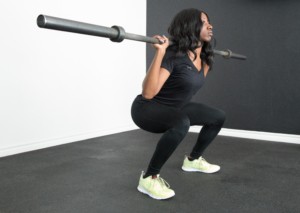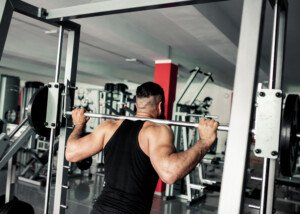
If you’re new to lifting weights, don’t let this stop you from doing the barbell squat, one of the best strength training exercises around.
When I was a personal trainer I had my clients–who’d never before lifted weights–learning to do the barbell squat.
But not before I carefully “screened” them for compatibility with this compound, fat burning exercise.
- In general beginners are good to go with the barbell squat, as long as they understand proper, safe form.
- Many beginners and even more experienced people have poor form.
The squat targets the glutes, upper legs, lower back and abdominals, and can be a major component of a fat burning workout regimen.

Shutterstock/Oleksandr Zamuruiev
Should beginners dive right into a free-barbell squat or first start out with the Smith machine?
This has a two-pronged answer. If you’re just not meant to do free-barbell squats, you can benefit from the Smith machine.

Freepik.com, senivpetro
On the other hand if your body is better proportioned for the free-barbell squat, and you don’t have issues with your spinal column such as stenosis, you can begin with a very light bar — once you feel comfortable doing bodyweight squats.
Some beginners are able to just jump right in and start squatting the Olympic bar (45 pounds).
Rushing into making it heavier, though, will put the beginner at risk for pulling a muscle.
The reason novices need to be careful with the barbell squat free across their upper back is because often, the unsuspecting person will round their lower back.
This increases risk of low back injury.
The novice must also make sure their feet are aligned, not uneven, and that their body is not leaning more to one side while conducting the movement.
One of my clients was a 60-year-old, obese woman who was very lost with her body positioning when just trying to squat the bar — on the Smith machine!
So this is where a case-by-case basis applies. This client did well on the leg press; she was no weakling; but her mind and body just could not connect when it came to even a Smith machine squat.
She’s an exception. There are plenty of older women and men who take to the free-barbell squat — with proper instruction.
Beginner’s Rules for a Safe Barbell Squat
- Keep feet flat on floor, at least shoulder width apart.
- Keep an arch in your lower back.
- Keep head tilted up a little, your eyes straight ahead or slightly upward.
- Keep the chest “puffed out.” Aim to get your thighs parallel to the floor. Past parallel is okay but not necessary when you’re a beginner.
Beginners can start out with a rep range of eight to 12. Rest a few minutes and repeat. Increase weight load with reason over time.
Don’t get ahead of yourself and start piling on plates; you can end up with a lower back strain or pulled area where the hamstring ties into the glute muscle.
Just because few beginners are ever seen at the squat “rack” or “cage” doesn’t mean that this fat burning exercise is reserved only for the experienced.









































